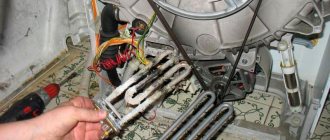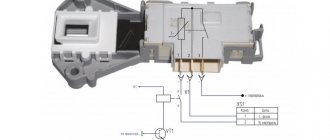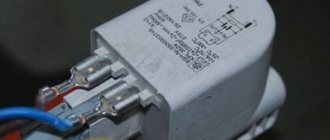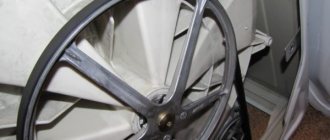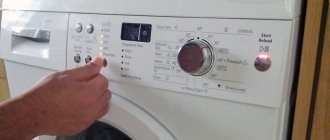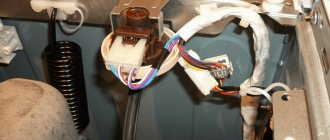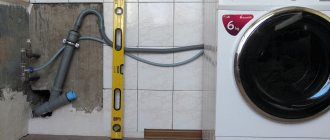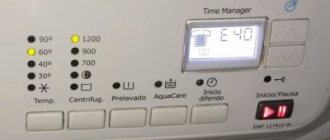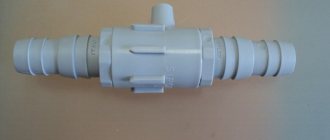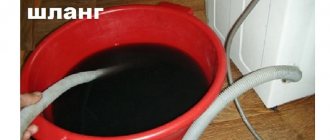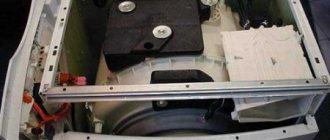What is the heating element of a washing machine? Location of the heating element in washing machines
Before disassembling the washing machine to get the heater, you need to determine where the heater is located in the washing machine.
It's not difficult - you just need to look at the back of the car and see how big the back cover is. If it is large, covering the entire wall, then most likely the heating element is located right behind it. Usually down under the washing tub.
In this case, removing the heating element is quite simple, since you just have to unscrew the back wall.
If the cover is small, then most likely it is a hatch to provide access to the machine belt. In this case, the heating element should be looked for at the front of the machine, behind the front panel. Disassembling it takes much longer and is more difficult than removing the back cover.
In any case, it is recommended to start by removing the back wall of the machine to understand where exactly the heater is located in this model. Moreover, it is completely easy.
If the instructions for the washing machine have not been preserved, then you can also be guided by the fact that for washing machines of the brands Zanussi (Zanussi), Kandy, Electrolux, Ariston, Indesit (Indesit), Virpul, Atlant, Beko (Veko), the heating element is usually located behind the back lid.
In Hans brand machines, in order to get the heating element, you need to remove the base panel. For this brand and for most machines that have a vertical principle of loading laundry, the heater is located on the side.
In washing machines of the Siemens, Samsung, Bosch, LG brands, in order to replace the heater, you will almost certainly have to remove the front decorative panel.
Before removing the heating element, it is necessary to drain the water from the machine, so you should prepare a rag and a container to collect the liquid in advance.
The algorithm for removing the heater is as follows:
- The wires leading to it are disconnected;
- The nut located in the middle of the heater is unscrewed;
- The threaded pin is pushed in - press it or hit it with a hammer (not too hard).
After this, by picking up the element with a knife or screwdriver, you can remove it. Sometimes this requires rocking it from side to side if the part is stuck.
Modern types of heating elements
Different heating elements differ from each other in the following parameters:
- length;
- bending;
- power;
- terminals;
- the presence or absence of a hole made specifically for the sensor;
- brand;
- for which tanks (plastic or iron).
1. The length of the heating element can be different. There are short models on the market (15 - 16 cm), medium (17 - 19 cm) or long (20 - 30 cm).
2. The power of the part varies from 1,600 to 2,200 W. Here heating elements can also be short (1,600 – 1,800 W) and long (1,800 – 2,000 W). The power determines how quickly the machine will heat up.
3. According to their bending, heating elements are divided into spiral and curved. It is necessary to take into account the amount of bending in degrees: 15, 30, 45 and more.
4. There is a hole for the sensor on the heating element at the base of the heating element. This element can only be replaced with a part with a hole. If it is not in the heating element, then a similar model is purchased.
5. Intended use for a tank made of a certain material means that you can determine the appropriate heating element for a particular washing machine based on the length of the elastic band that is needed to attach the heating element. If its size is 1.5 cm or less, then it is perfect for an iron tank. If the elastic band in the model exceeds 1.5 cm, then it is used for plastic tanks.
6. The brand that produced the heating element must be taken into account. For washing machines from Europe (Austria, Germany, Italy), it is recommended to purchase heating elements from European manufacturers. If the part was manufactured in Asia, then it is better to consult your sales manager. So, for a German BOSCH washing machine, the best solution is a BOSCH TEN!
What is a dry heating element for a water heater? “Dry” heating element - design and features
The heating element of such a heating element is also a nichrome spiral. But it is not inserted into the tube and is insulated not with filler, but with ceramic insulators.
Dry heater appearance
Individually, its elements look like this:
Individual elements of a “dry” heating element
It is clear from the drawings that such a device cannot be immersed in water. It is not intended for contact with water, hence the name “dry”. The assembled heater is installed in a special flask made of metal or heat-conducting ceramics. The surface of the metal flasks is coated with anti-corrosion enamel.
"Dry" heater in a flask
And the flask itself is built into a heated container and insulated with gaskets. Unlike the wet version, both the flask and the heater itself are always made in a straight shape, without any bends. And the “dry” heating element is installed in the water heater only in the lower part of the tank.
Dry installation of a heater in a boiler
The fact that the heating element itself does not come into contact with the inner surface of the installation flask limits the rate of initial heating of the water. And although the gaps between the heating element itself and the wall of the flask are minimal, some time is still spent warming up the air gap. For this reason, current dry-type designs are not installed in instantaneous water heaters, and they are used only in storage water heating systems.
Location of the heating element in the washing machine
In order to find the heating element you need to remove the back panel. As soon as you remove the cover and put it back, you will be able to see a plastic tank at the bottom, which will contain the contacts of the heating element, as well as the contacts of the temperature sensor. In some cases, the heating element contacts are located on the side, so you will have to remove the side panels to get to them.
If you find the heating element contacts at the top, then these are not the contacts you need. This is a heating element for drying, which is of no interest to us now, but it is worth checking, and it is checked in the same way as a heating element for water.
In order to measure resistance, there is no need to remove the heating element itself. Also, not far from the heating element or between its contacts, you can find the contacts of the temperature sensor.
Changing the heating element is not difficult. You need to unscrew and remove the non-working element, replacing it with a new sample. After all the fasteners are tightened, you need to check the tank for leaks.
TEN, what is it? Tubular electric heater
A tubular electric heater (TEH) is an electric heating device in the form of a metal tube filled with a heat-conducting electrical insulator. A conductive thread (usually nichrome or fechral) of a certain resistance passes precisely through the center of the insulator to transfer the required specific power to the surface of the heating element.
It is used in many household and industrial electrical appliances: kettles, boilers, washing machines, water heating and heating boilers, etc.
The PETN was invented and patented on September 20, 1859 by George B. Simpson in Washington, DC.
Double-ended heating element of an electric stove in the form of a spiral. Power regulation with a rheostatic switch or cyclic on-off over time
A single-end heating element of an electric stove in the form of a spiral with three heating threads of different resistance connected at the blind end of the heating element. Power regulation by combining current supply to the terminals with a switch (1 ~ 2 0; 1~30; 2~30; 1~2~30)
Tubular electric heaters can have different diameters ranging from 6 to 24 mm. Depending on the specific application (heating liquid or air), in the production of heating elements, electrical insulators (dielectrics) of various qualities are used, which must retain their dielectric properties at low, high and extremely high temperatures.
According to their configuration, heating elements are divided into double-ended (when the contact terminals are located on both sides) and single-ended (“cartridge”) - with contact terminals located on one side of the heater. Electric boilers usually contain blocks of heating elements, or, as they are also called, “TENB”.
Heating element for a washing machine, what is it. How to choose a heating element for a washing machine
How to choose a heating element (heating element) for a washing machine according to the brand of equipment.
Seat
The most important thing when selecting a heating element is that the seat fits. Almost all heating elements have the same place. The exception is heating elements on old washing machines that are more than 12 - 13 years old.
Presence of a collar
The presence of a collar must be taken into account. If instead of a heating element that did not have a collar, you put a heating element with a collar, then this heating element may fly out of the tank during washing. In principle, it is possible to install a heating element without a collar in place of a heating element with a collar, but it is not advisable.
Hole for sensor
Some heating elements have a special hole for the sensor. On all heating elements that come with a sensor, this sensor can always be pulled out, even if it seems that it is sealed. Instead of a heating element without a hole, you can install a heating element with a hole using a special plug. There are models on LG washing machines that have heating elements with a sensor, but nothing is connected to the sensor. In this case, you can install a heating element without a hole.
Heating element length
After that there is a difference in length. Heating elements are short, medium and long. It is advisable to take the length into account, but if the new heating element is a little longer or shorter than the old one, then it’s okay. You can also install a short heating element instead of a long one, but a long heating element will not fit in place of a short one (it may not fit).
Heating element power
Next comes power. Power doesn't matter. If the heating element is more powerful, then it will heat the water a little faster, and if it is less powerful, then it will heat the water a little longer. The difference will not be noticeable.
Heating element shape
Another point is the shape of the heating element. Almost all heating elements are straight, but sometimes curved ones are found. This must also be taken into account.
Heating element coating
Some models of washing machines are equipped with heating elements with ceramic or other coatings. It is not of fundamental importance; it may last a little longer.
Manufacturers of heating elements
- Thermowatt (the best in quality, these heating elements are stamped “made in Italy”)
- IRCA (second in quality, but these heating elements come with a fuse)
- Blackmann (worse heating elements, very rare)
The manufacturer does not matter, the main thing is that the heating element fits other parameters.
Brand selection process
- Samsung, Indesit, Ariston - short heating elements with a hole, without a collar. Some Samsungs have ceramic heating elements. Instead of them, you can install ordinary short heating elements with a hole.
- LG – short heating elements without holes. Some models come with heating elements with sensors.
- Bosch, Siemens - medium heating elements with a collar and a hole.
- Candy – long heating elements without a hole, with a collar.
- Electrolux, Zanussi - long heating elements with a hole, with a collar.
- Ardo - sometimes there are curved heating elements with or without a hole.
- Older models of the brands listed above may have other heating elements. Basically, long heating elements were installed in the past. There may or may not be a hole for the sensor.
This list is indicative only. Discrepancies are possible!
Signs that the heating element has burned out
- The washing machine does not heat the water
- The washing machine fills with water and stops or turns off after 5 minutes
- 5 minutes after the washing machine starts working, the plugs break out
- The smell of burning
- The washing machine does not wash well
- The washing machine is electrocuted
In our catalog of spare parts for washing machines, you can select the appropriate heating element for your washing machine based on the brand or size of the heating element. You can order a spare part on our website, or by calling.
How does a heating element work in a washing machine (principle of operation)
Installation tips are the same for almost all automatic machines, because their design is very similar to each other. If the heating element breaks down, then further operation of the washing machine becomes impossible - it stops executing the program and displays an error.
Design
In an automatic washing machine, the heating element is presented in the form of a tubular structure, which is responsible for heating the water. In the middle of this structure there is a thin conductor made of a special alloy that has high resistance and is capable of heating to high temperatures without destruction. The spiral insulates from the steel outer shell a dielectric material with high thermal conductivity.
The ends of the spiral are soldered to the contacts, and supply voltage is applied to them. Most often, there is a thermocouple located right there, which is responsible for measuring the temperature of the water in the washing machine tank. When a program is started, supply voltage is supplied to the heating element from the control unit, it heats up itself and begins to heat the water. As soon as the set temperature is recorded by the sensor , the control unit will turn off the heating element and water heating will stop.
Power
Sometimes the power of the heating elements reaches 2.2 kW. The stronger the heating element, the faster the water will heat up in the machine, and the faster the washing will begin. It is also very important that heating elements have high inertia and resistance, so they almost do not react to surges in the electrical network. Increased short-term voltage in the network does not have a visible effect on the conductor located inside the heating element. Thanks to this, the service life of the heating elements is increased.
What is a heating element in a washing machine? Heating element for washing machine
Among the main elements of a household washing machine, a special role is given to the heating element. If it fails, the equipment stops working properly. The malfunction of this element is the main reason for contacting the repair service.
What is a heating element in a washing machine, the main function
A tubular electric heater is a tube with a spiral inside, which consists of a heat-conducting insulator and a conductive thread. The curved tube of the heating element is attached at both ends to the flange. A special gasket on the flange allows for a tight installation when tightening the nut. In order to securely fix the heating element, it is necessary to perform the installation correctly.
The main function of the heating element is to heat water to a certain temperature set by the washing mode.
Failure of the tubular electric heater is the main cause of errors or program freezes. If the washing machine does not heat the water, then the heating element is most likely to blame.
The service life of an important element is influenced by many factors:
- part quality;
- hardness of water;
- washing temperature.
- The heating element often breaks due to the formation of a thick layer of scale on it.
Modern types of heating elements
Different heating elements differ from each other in the following parameters:
- length;
- bending;
- power;
- terminals;
- the presence or absence of a hole made specifically for the sensor;
- brand;
- for which tanks (plastic or iron).
1. The length of the heating element can be different. There are short models on the market (15 - 16 cm), medium (17 - 19 cm) or long (20 - 30 cm).
2. The power of the part varies from 1,600 to 2,200 W. Here heating elements can also be short (1,600 – 1,800 W) and long (1,800 – 2,000 W). The power determines how quickly the machine will heat up.
3. According to their bending, heating elements are divided into spiral and curved. It is necessary to take into account the amount of bending in degrees: 15, 30, 45 and more.
4. There is a hole for the sensor on the heating element at the base of the heating element. This element can only be replaced with a part with a hole. If it is not in the heating element, then a similar model is purchased.
5. Intended use for a tank made of a certain material means that you can determine the appropriate heating element for a particular washing machine based on the length of the elastic band that is needed to attach the heating element. If its size is 1.5 cm or less, then it is perfect for an iron tank. If the elastic band in the model exceeds 1.5 cm, then it is used for plastic tanks.
6. The brand that produced the heating element must be taken into account. For washing machines from Europe (Austria, Germany, Italy), it is recommended to purchase heating elements from European manufacturers. If the part was manufactured in Asia, then it is better to consult your sales manager. So, for a German BOSCH washing machine, the best solution is a BOSCH TEN!
How to clean the heating element in a washing machine yourself
Timely cleaning of the washing machine will help maintain its performance for a long time. The insidious scale can cause enormous harm. It is formed when the heating element heats the water. Potassium and magnesium salts break down, forming carbon dioxide and a precipitate called scale.
Today there are washing powders on sale that soften hard water and improve its quality: they contain acid. During the washing process, it can dissolve scale, so when choosing the right product, you don’t have to worry about the cleanliness of your household appliance.
Owners of washing machines who previously did not know about special powders and did not use them can take advantage of the opportunity to clean the heating element with citric acid. To do this, you will need to perform a series of sequential actions:
- 200 g of citric acid is poured into the laundry tank.
- The main wash program is set at maximum temperature.
- The washing machine turns on.
While household appliances are running, the acid cleans not only the heating element, but also the inner surface of the drum and tank. The housewife can make cleaning more effective if she adds an additional 200 g of bleach. This procedure will return the washing machine to its original condition. The owner of Zanussi equipment will never face the problem of washed clothes. Cleaning should be done every 2 months. However, there are also disadvantages here. When citric acid is used constantly, it can destroy not only limescale, but also rubber parts.
Other common problems include leaking drain hoses. Only replacing the faulty element will help eliminate the leak. Before you make a purchase, you need to study the advantages and disadvantages of different models of drain pumps. After analyzing all the possible offers, the owner of the washing machine will make the best choice.
How to check the heating element of a washing machine
If, when you touch the glass of the loading hatch or the top cover (for machines with vertical loading), you find that the water is cold in modes that involve heating it, the cause may be a malfunction of the heating element. It also happens that the washing machine does not rinse or spin clothes and signals an error by flashing all the lights. In these cases, it is necessary to check the heating element for functionality. The surest way to check is to measure the resistance with a multimeter.
In order for the measurements to give results, it is necessary to make simple calculations and find the calculated resistance of the heating element using the formula:
R=U²/P where:
R – resistance in Ohm;
U – network voltage in V;
P – heating element power W.
If the marking of the heating element or the passport for the washing machine indicates a power of 1800 W, then we get
R=220²/1800=26.8 Ohm.
Having received a calculated resistance of 26.8 Ohms, we proceed to check the heating element. For accurate measurements, disconnect the heating element from all wires. We switch the multimeter to resistance measurement mode for the 200 Ohm range. We apply the probes of the device to the extreme contacts and look at the readings of the device. If the readings are close to the calculated figure, the reason for the lack of water heating is not in the heating element and its replacement is not required. If the multimeter display shows “zero”, this indicates an internal short circuit, and the heating element must be replaced. If the device shows “one” or “infinity”, the conductive thread has broken, and in this case the heating element must be replaced with a new one.
In addition, using a multimeter, you need to check the heating element for breakdown on the housing. For this purpose, the multimeter has a “dialing” mode. If in this mode both probes of the device are connected to each other, a characteristic sound is emitted and the light indication lights up. To check, we switch the device to this mode and touch one of the heating element terminals with one probe, and the tubular body with the other. The sound of the device and the lighting of the indicator will notify of a breakdown on the housing. In this case, it is also necessary to replace the heating element.
If checking the heating element confirms its serviceability, there is no need to dismantle it. The reasons for the lack of heating of water may also include:
- faulty heating element relay, which is responsible for supplying voltage to it;
- malfunction of the thermostat or temperature sensor;
- malfunction of the electronic module.
Attention! All work on checking the heating element and disassembling the washing unit must be carried out only with the power turned off.
Dry heating element water heater, what is it. Features of water heaters with wet heating elements
This type of heating part is one of the most popular and widespread. The wet heating element works directly with liquids. Direct interaction can negatively affect the part itself. Unlike the dry type, scale marks appear faster on the wet type and metal corrosion will occur. They include the following elements in their design:
- Metal tube
- Spiral
- Dielectric filler (it prevents electrical overvoltage)
Despite the fact that boilers have their negative sides, the quality of heating in mechanisms with a wet heating element does not change. In addition, they have other positive qualities, such as price. An open type device will cost several times less than a closed one. Additional equipment for the mechanism also costs less. A good example of this type of heaters is the products of THERMEX. If problems arise, a specially built-in tube will help drain all the water to begin repair work.
Tip: Any heating element will work with such devices; you won’t have to look for a part for a specific model.
What is a heating element in an oven? Communicate with ovens in the same language
When a housewife gets acquainted with a new oven, the first thing she encounters is the need for translation.
And not in the sense from one language to another, but more often from the names inherent in each company to generally accepted terms. What is it for? It's simple, you can compare one oven with another only when the object of comparison is clear. Therefore, we avoid pretentious, and most importantly, incomprehensible expressions such as “turbo air”, “maxi-grill”, “intense hot air”, “thermal circulation” or “3-0 convection”. And if the description includes some function like “slow baking” or “gratin”, we strive to “shake” the whole truth from the brand department about how it works.
Therefore, the technical characteristics in manufacturers’ catalogs look much brighter and more seductive than our boring, but understandable data. We will not deviate from this rule now, so we assign the same names to the modes that you will see on the following pages of the review.
Don't forget to reheat
At the beginning of the story - some general advice. In the instructions for ovens (which we actively use), for successful cooking, it is recommended to preheat them to the required temperature (we focus on the thermostat indicator lamp; it should go out).
Only for very fatty meat can you make an exception and put it in a cold oven. In this case, the cabinet can be turned off a few minutes before it is ready; the residual temperature will be sufficient for the successful completion of the process. It is advisable to open the door as little as possible, and observe the “behavior” of the products through the glass (this is why the backlight often does not turn off while cooking is in progress).
What is a heating element? Advantages of heating elements
Compared to other types of heaters, heating elements have many advantages.
For example, they can also be used when there is direct contact of the heater with the heated medium. And, as you know, these can be a wide variety of options, not just liquid and gaseous. The medium can even be solid, and the pressure in it can reach up to 4.5 atm. And this will not become an obstacle for the heating element. The advantage of tubular electric heaters is their reliable operation during vibrations, as well as when there are significant shock loads. In addition, they have different configurations. And there is no voltage on the shell of the heating elements.
There is such an important indicator as mean time to failure. When using heating elements to heat air media, it is at least 10 thousand hours. When used to heat liquid media – at least 5 thousand hours.
A double-ended round heating element has a design where the heating element is located inside a metal shell. This is, for example, a spiral or several spirals made of a high-resistance alloy. There are also contact rods there.
The compressed electrical insulating filler serves as an insulator between the shell and the heating element. In order to prevent moisture from entering from the environment, the ends of the heating elements are sealed. There are also dielectric insulators between the contact rods and the shell.
Checking and replacing the heating element in the washing machine
Tubular electric heater (TEH) is the heating element of a washing machine.
It is the heating element that heats the cold water coming from the water supply in any washing unit. If the machine does not heat the water well or does not heat the water at all, most likely the heating element is faulty or has already burnt out.
If the heating element is still working, it is enough to clean . A failed electric heater cannot be repaired and must be replaced with a similar new one.
Is it possible for a person unfamiliar with technology to check and replace the heating element in a washing machine? How to replace the heating element?
Heating element with thermostat. A heating element with a thermostat will heat the water safely and quickly
Heating elements with a built-in thermostat are found almost everywhere where water heating is needed, from factory boilers to homemade convectors made from a cast iron radiator. What advantages and disadvantages does this device have? Let's figure it out.
How it works and how to choose
A heating element with a built-in thermostat has a simple structure, consisting of two parts, a heating element and a temperature sensor connected to a temperature controller. But even here there are several features that significantly affect the serviceability and service life of the device.
- The first thing you should look at when buying is its body. A more durable heating element will be made of copper and have a corresponding noble color; a cheaper option is usually made of “acid-resistant stainless steel”. There is no way to verify how durable this stainless steel really is in the store, so give preference to the brass version of the case. The outer diameter of the tube is usually 13 mm, but there are also thin, low-power options - 10 and even 8 mm;
The steel body of the heating element with a thermostat is usually a little cheaper
The copper heating element body gives more hope for long-term operation - Marking.
Since we are considering a heating element for a water heater, you should make sure that in the marking, before the designation of the operating voltage 220V, there is the letter “P”, indicating operation in water and weak alkaline solutions; Symbols on the heating element body - Power. It should be taken into account that when connecting to a regular home network, you should not use a heating element more powerful than 2.5 kW - this puts too much load on the regular wiring. If you plan to connect a more powerful heating element with a thermostat, lay a separate cable from the panel with the appropriate cross-section to the installation site.
- The temperature sensor is located in a separate tube and, if necessary, is removed from it along with the thermostat. Svidu is a rod. It contains a thermocouple inside, which, when heated, activates the thermostat mechanism. Often, the failure of the temperature sensor causes the heating element to turn off at low temperatures.
Heating element for a washing machine: do-it-yourself replacement:
A heating element is a tubular electric heater necessary for heating water during operation of an automatic washing machine. During long-term use, the heating element for a washing machine becomes covered with dirt and scale, which leads to burnout of the internal heating coil. This part can have different shapes, brands and manufacturers.
When does the heating element need to be replaced?
It is not difficult to recognize the moment when it is necessary to replace the heating element in a washing machine. The first sign is that the water stops heating. The reason for this is hard water.
In this case, lime deposits form in the place where the heating element of the washing machine is installed. The part on which scale has appeared ceases to generate the required heat transfer, overheating occurs and, accordingly, it fails.
Since models of modern washing machines do not provide for replacing the thermal fuse element, it is necessary to replace the entire part.
Signs of heating element failure
Failure of the heating element can be determined by the following signs:
- During washing mode, the body of the washing machine does not heat up.
- The water remains cold during the washing process.
How to choose a heating element for a washing machine
On modern washing machines, heating elements may vary:
- according to form;
- in size;
- fastening diagram;
- power;
- tension;
- the presence of connectors for a temperature sensor and a thermal fuse.
But despite this variety, choosing the right part is quite simple. In most cases, you should know the manufacturer and model of the device, especially since for the most part heating elements for washing machines are universal, that is, they are suitable for many models.
There are cases when it is impossible to buy an original part for a washing machine, in this case it is allowed to replace it with a similar one, you only need to meet a number of conditions:
- the length of the heating element may vary by plus/minus 10 millimeters (measured from end to base);
- possible power error - 100-150 W (the parameter is indicated on the basis of the heating element);
- if the original heating element has a connector for a temperature sensor, the analogue should also have one;
- the place and degree of bending on the analogue, the number of terminals and their location must exactly correspond to the original.
Replacing the heating element
So, we change the heating element for the washing machine. We can take LG as an example. The part must always be in water during the washing mode, which is why it is installed from the back of the washing machine body. Step-by-step removal of the heating element:
- Make sure the equipment is unplugged.
- Remove the back cover by unscrewing the screws. The heating element is located under the drum pulley (in models with direct drive, under the motor).
- To make it more convenient, you can unfasten the drive belt, after which you need to remove three drives from the terminals of the heating element: one for grounding and two for supply. It is also necessary to remove the connector from the temperature sensor (if equipped);
- In the center of the heating element screw, loosen the nut 5-6 turns and push the screw inward.
- Take two screwdrivers, use them to pick up and remove the heating element for the washing machine (you will need to make an effort, since the sealing rubber can be pressed hard).
- Clean the hole from fragments of dirt and scale.
Replacing the heating element in a washing machine
Installation of the new part is carried out in the reverse order:
- In the direction of the guide bracket inside the washing machine tank, firmly install the heating element, tighten the nut of the main screw. There is no need to clamp it tightly; screw the nut until there is a slight resistance to clamping.
- Place the belt on the motor and drum pulley. After spinning the drum, check that the belt runs in the center of the pulley and does not rub the supplied electric motor.
- After that, connect the electrical wires and check again.
- Run a dry wash to check if there are any water leaks and if the water gets hot during operation.
- If no problems arise, close the lid and return the machine to its original place.
The heating element for a front-mounted washing machine changes in the same way, but in this case you will need to remove the front part of the housing.
The process of replacing a heating element is not complicated, however, if you do not understand technology or are not confident in success, it is better to entrust the replacement of the heating element to specialists who usually provide a guarantee for the work performed.
